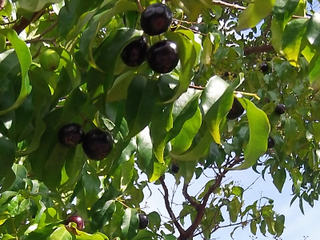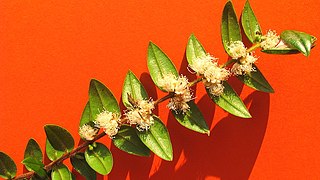
Myrtaceae, the myrtle family, is a family of dicotyledonous plants placed within the order Myrtales. Myrtle, pōhutukawa, bay rum tree, clove, guava, acca (feijoa), allspice, and eucalyptus are some notable members of this group. All species are woody, contain essential oils, and have flower parts in multiples of four or five. The leaves are evergreen, alternate to mostly opposite, simple, and usually entire. The flowers have a base number of five petals, though in several genera, the petals are minute or absent. The stamens are usually very conspicuous, brightly coloured, and numerous.

Myrciaria dubia, commonly known as camu-camu, caçari, araçá-d'água, or camocamo, is a species of plant in the family Myrtaceae. It is a small bushy riverside tree from the Amazon rainforest in Peru and Brazil, which grows to a height of 3–5 m (9.8–16.4 ft) and bears a red/purple cherry-like fruit. It is a close relative of the false jaboticaba and the guavaberry or rumberry. As much as 2 to 3% of the fresh fruit by weight is vitamin C.

Myrciaria floribunda, commonly known as cambuizeiro, guavaberry or rumberry, is a species of plant in the family Myrtaceae. It can be found across South and Central America and the West Indies in dry or moist coastal woodlands, up to 300 metres above sea level. The guavaberry, which should not be confused with the guava, is a close relative of camu camu.

Jabuticaba, also spelled Jaboticaba, is the edible fruit of the jabuticabeira or Brazilian grapetree. The purplish-black, white-pulped fruit grows directly on the trunk of the tree, making it an example of 'cauliflory'. It is eaten raw or used to make jellies, jams, juice or wine. The tree, of the family Myrtaceae, is native to the states of Rio de Janeiro, Minas Gerais, Goiás and São Paulo in Brazil. Related species in the genus Myrciaria, often referred to by the same common names, are native to Brazil, Argentina, Paraguay, Peru and Bolivia.

Myrciaria is a genus of large shrubs and small trees described as a genus in 1856. It is native to Central and South America, Mexico, and the West Indies, with many of the species endemic to Brazil. Common names include hivapuru, sabará, and ybapuru.
Myrciaria cuspidata, commonly known as camboim, or cambuím is a species of plant in the family Myrtaceae. It is found in coastal forests and semideciduous forests in Brazil, Paraguay and Argentina. It grows slowly to a semideciduous shrub or small tree, between 3 and 6 metres tall, with orange or black berries around 10mm in diameter.
Myrciaria plinioides, commonly known as camboim, cambuim, or cambuí, is a species of plant in the family Myrtaceae. It is a shrub that is endemic to Rio Grande do Sul in the south of Brazil.

Eugenia candolleana, or rainforest plum, is a tree native from Atlantic rainforest of Brazil, known locally by the Portuguese names cambuí roxo or murtinha. It is quite rare in the wild, and has seen limited use in landscaping for its bright green foliage and purple-black fruits.

Melaleuca glomerata, commonly known as the desert honey-myrtle, inland paperbark or white tea-tree is a plant in the myrtle family Myrtaceae native to inland Australia. It is a small tree or shrub growing in arid areas, often in creek beds and shallow depressions.
Myrciaria vismeifolia is a species of plant in the family Myrtaceae. It has been found in Bolivia, Brazil, French Guiana, Guyana, Panama, Suriname, and Venezuela. The tree grows to between 4 and 6 metres high, and produces an edible berry up to 10mm in diameter.
Myrciaria delicatula, commonly known as cambuí uvaia doce, cambuí graudo, cambuim, or cambu branco, is a species of plant in the family Myrtaceae.

Myrciaria strigipes, commonly known as cambucá da praia or cabeludinha da praia, is a species of plant in the family Myrtaceae. It is an evergreen shrub or small tree, endemic to Bahia and Espírito Santo in the east of Brazil. The plant grows up to between 4 and 9 metres tall, and produces edible yellowish fruits between 22 and 28mm in diameter. Consumed raw, the fruit has been described as tasting somewhere between Myrciaria glazioviana and Plinia cauliflora.
Myrciaria pilosa, commonly known as cambucá do sertão is a species of plant in the family Myrtaceae. It is endemic to the state of Ceará in the north-east of Brazil. The plant is a small tree that grows to between 1.5 and 2 metres tall, and produces edible, red, spherical fruit round 20mm in diameter.
Myrciaria alagoana is a species of plant in the family Myrtaceae and is endemic to the state of Alagoas in the east of Brazil. Myrciaria alagoana was first described in 2012 and is related to Myrciaria glomerata.
Myrciaria disticha is a species of plant in the family Myrtaceae. It is endemic to the east of Brazil. The plant is a semideciduous shrub or small tree that grows to between 4 and 6 metres tall, and produces edible, reddish berries around 10mm in diameter.

Myrciaria ferruginea is a disputed species of plant in the family Myrtaceae and is endemic to the east of Brazil. Some authorities believe that this plant is a synonym of Myrciaria floribunda.
Myrciaria tenella, commonly known as cambuí or camboim, which are also used to describe Myrciaria cuspidata and Myrciaria delicatula; or more specifically jabuticaba-macia, and cambuí-açu, is a species of plant in the family Myrtaceae.
Myrciaria alta is a species of plant in the family Myrtaceae, endemic to Espírito Santo, Brazil. It was first described in 2019 and it is closely related to Myrciaria glomerata.

Micromeria glomerata, known locally as cliffthyme or thyme of Taganana, is a species of plant with woody chameleophyte flowers, belonging to the Lamiaceae family. It is a species endemic to the northeast of the Canary Island of Tenerife, whose description was first made in 1974, thanks to botanist Pedro Luis Pérez de Paz. It is a medicinal and aromatic plant with pink-purple flowers that grows at low altitude in the crevices of the slopes of the protected area of the Anaga Rural Park, located in the massif of the same name. The flexible, puberulose stem and with internodes can reach 10 to 40 centimeters in height. On the other hand, the leaves are small and flat, 8 mm long by 6 mm wide.11











